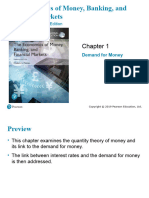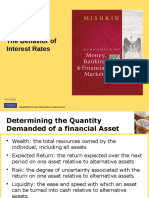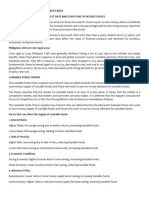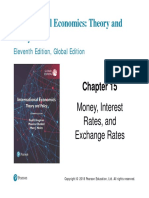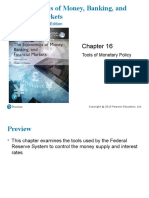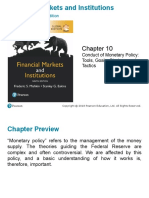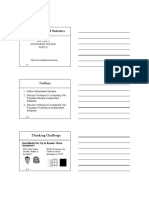0 ratings0% found this document useful (0 votes)
29 viewsThe Economics of Money, Banking, and Financial Markets: Twelfth Edition, Global Edition
The Economics of Money, Banking, and Financial Markets: Twelfth Edition, Global Edition
Uploaded by
Hiền Nguyễnfasg
Copyright:
© All Rights Reserved
Available Formats
Download as PDF, TXT or read online from Scribd
The Economics of Money, Banking, and Financial Markets: Twelfth Edition, Global Edition
The Economics of Money, Banking, and Financial Markets: Twelfth Edition, Global Edition
Uploaded by
Hiền Nguyễn0 ratings0% found this document useful (0 votes)
29 views38 pagesfasg
Original Title
Lecture 3
Copyright
© © All Rights Reserved
Available Formats
PDF, TXT or read online from Scribd
Share this document
Did you find this document useful?
Is this content inappropriate?
fasg
Copyright:
© All Rights Reserved
Available Formats
Download as PDF, TXT or read online from Scribd
Download as pdf or txt
0 ratings0% found this document useful (0 votes)
29 views38 pagesThe Economics of Money, Banking, and Financial Markets: Twelfth Edition, Global Edition
The Economics of Money, Banking, and Financial Markets: Twelfth Edition, Global Edition
Uploaded by
Hiền Nguyễnfasg
Copyright:
© All Rights Reserved
Available Formats
Download as PDF, TXT or read online from Scribd
Download as pdf or txt
You are on page 1of 38
The Economics of Money, Banking, and
Financial Markets
Twelfth Edition, Global Edition
Chapter 5
The Behavior of Interest
Rates
Copyright © 2019 Pearson Education, Ltd.
Preview
• In this chapter, we examine how the overall level of
nominal interest rates is determined and which factors
influence their behavior.
Copyright © 2019 Pearson Education, Ltd.
Learning Objectives (1 of 2)
• Identify the factors that affect the demand for assets.
• Draw the demand and supply curves for the bond market
and identify the equilibrium interest rate.
• List and describe the factors that affect the equilibrium
interest rate in the bond market.
Copyright © 2019 Pearson Education, Ltd.
Learning Objectives (2 of 2)
• Describe the connection between the bond market and the
money market through the liquidity preference framework.
• List and describe the factors that affect the money market
and the equilibrium interest rate.
• Identify and illustrate the effects on the interest rate of
changes in money growth over time.
Copyright © 2019 Pearson Education, Ltd.
Determinants of Asset Demand (1 of 2)
• Economic agents hold a variety of different assets. What
are the primary assets you hold?
• An asset is anything that can be owned and has value.
Copyright © 2019 Pearson Education, Ltd.
Determinants of Asset Demand (2 of 2)
• Wealth: the total resources owned by the individual,
including all assets
• Expected Return: the return expected over the next
period on one asset relative to alternative assets
• Risk: the degree of uncertainty associated with the return
on one asset relative to alternative assets
• Liquidity: the ease and speed with which an asset can be
turned into cash relative to alternative assets
Copyright © 2019 Pearson Education, Ltd.
Theory of Portfolio Choice (1 of 2)
Holding all other factors constant:
1. The quantity demanded of an asset is positively
related to wealth
2. The quantity demanded of an asset is positively
related to its expected return relative to alternative
assets
3. The quantity demanded of an asset is negatively
related to the risk of its returns relative to alternative
assets
4. The quantity demanded of an asset is positively
related to its liquidity relative to alternative assets
Copyright © 2019 Pearson Education, Ltd.
Theory of Portfolio Choice (2 of 2)
Summary Table 1
Response of the Quantity of an Asset Demanded to Changes in Wealth,
Expected Returns, Risk, and Liquidity
Variable Change in Variable Change in Quantity
Demanded
Wealth ↑ ↑
Expected return relative to other assets ↑ ↑
Risk relative to other assets ↑ ↓
Liquidity relative to other assets ↑ ↑
Note: Only increases in the variables are shown. The effects of decreases in the variables on the quantity demanded
would be the opposite of those indicated in the rightmost column.
Copyright © 2019 Pearson Education, Ltd.
Supply and Demand in the Bond Market
• At lower prices (higher interest rates), ceteris paribus, the
quantity demanded of bonds is higher: an inverse
relationship
• At lower prices (higher interest rates), ceteris paribus, the
quantity supplied of bonds is lower: a positive relationship
Copyright © 2019 Pearson Education, Ltd.
The Relationship between Bond Prices and
Interest Rate
• The yield to maturity of a discounted bond is
−
=
• The yield to maturity of a consol/perpetuity bond is
Copyright © 2019 Pearson Education, Ltd.
Figure 1 Supply and Demand for Bonds
Copyright © 2019 Pearson Education, Ltd.
Market Equilibrium
• Occurs when the amount that people are willing to buy
(demand) equals the amount that people are willing to sell
(supply) at a given price.
• Bd = Bs defines the equilibrium (or market clearing) price
and interest rate.
• When Bd > Bs , there is excess demand, price will rise and
interest rate will fall.
• When Bd < Bs , there is excess supply, price will fall and
interest rate will rise.
Copyright © 2019 Pearson Education, Ltd.
Changes in Equilibrium Interest Rates
• Shifts in the demand for bonds:
– Wealth: in an expansion with growing wealth, the demand
curve for bonds shifts to the right
– Expected Returns: higher expected interest rates in the
future lower the expected return for long-term bonds,
shifting the demand curve to the left
– Expected Inflation: an increase in the expected rate of
inflations lowers the expected return for bonds, causing the
demand curve to shift to the left
– Risk: an increase in the riskiness of bonds causes the
demand curve to shift to the left
– Liquidity: increased liquidity of bonds results in the demand
curve shifting right
Copyright © 2019 Pearson Education, Ltd.
Figure 2 Shift in the Demand Curve for
Bonds
Copyright © 2019 Pearson Education, Ltd.
Shifts in the
Demand for
Bonds
Summary Table 2
Copyright © 2019 Pearson Education, Ltd.
Shifts in the Supply of Bonds (1 of 2)
• Shifts in the supply for bonds:
– Expected profitability of investment opportunities: in an
expansion, the supply curve shifts to the right
– Expected inflation: an increase in expected inflation
shifts the supply curve for bonds to the right
– Government budget: increased budget deficits shift the
supply curve to the right
Copyright © 2019 Pearson Education, Ltd.
Shifts in the Supply
of Bonds (2 of 2)
Summary Table 3
Copyright © 2019 Pearson Education, Ltd.
Figure 3 Shift in the Supply Curve for Bonds
Copyright © 2019 Pearson Education, Ltd.
Figure 4 Response to a Change in Expected
Inflation
Copyright © 2019 Pearson Education, Ltd.
Figure 5 Expected Inflation and Interest Rates
(Three-Month Treasury Bills), 1953–2017
Sources: Federal Reserve Bank of St. Louis FRED database: https://fred.stlouisfed.org/series/TB3M;
https://fred.stlouisfed.org/series/CPIAUCSL.S. Expected inflation calculated using procedures outlined in Frederic S.
Mishkin, “The Real Interest Rate: An EmpiricalInvestigation,” Carnegie-Rochester Conference Series on Public Policy 15
(1981): 151–200. These procedures involve estimating expected inflation as a function of past interest rates, inflation, and
time trends.
Copyright © 2019 Pearson Education, Ltd.
Figure 6 Response to a Business Cycle
Expansion
Copyright © 2019 Pearson Education, Ltd.
Figure 7 Business Cycle and Interest Rates
(Three-Month Treasury Bills), 1951–2017
Source: Federal Reserve Bank of St. Louis FRED database: https://fred.stlouisfed.org/series/TB3MS
Copyright © 2019 Pearson Education, Ltd.
Supply and Demand in the Market for Money:
The Liquidity Preference Framework (1 of 2)
Keynesian model that determines the equilibrium interest
rate in terms of the supply of and demand for money.
There are two main categories of assets that people use to
store their wealth: money and bonds.
Total wealth in the economy = Bs + Ms = Bd+ Md
Rearranging: Bs − Bd = Ms − Md
If the market for money is in equilibrium (Ms = Md ),
then the bond market is also in equilibrium (Bs = Bd ).
Copyright © 2019 Pearson Education, Ltd.
Figure 8 Equilibrium in the Market for
Money
Copyright © 2019 Pearson Education, Ltd.
Supply and Demand in the Market for Money:
The Liquidity Preference Framework (2 of 2)
• Demand for money in the liquidity preference framework:
– As the interest rate increases:
The opportunity cost of holding money increases…
The relative expected return of money decreases…
– …and therefore the quantity demanded of money
decreases.
Copyright © 2019 Pearson Education, Ltd.
Changes in Equilibrium Interest Rates in
the Liquidity Preference Framework (1 of 3)
• Shifts in the demand for money:
– Income Effect: a higher level of income causes the
demand for money at each interest rate to increase
and the demand curve to shift to the right
The rises in income cause wealth to increase
People need to carry out more transactions
– Price-Level Effect: a rise in the price level causes the
demand for money at each interest rate to increase
and the demand curve to shift to the right
People care about their money of holding in real
terms
Copyright © 2019 Pearson Education, Ltd.
Changes in Equilibrium Interest Rates in
the Liquidity Preference Framework (2 of 3)
• Shifts in the supply of money:
– Assume that the supply of money is controlled by the
central bank.
– An increase in the money supply engineered by the
Federal Reserve will shift the supply curve for money
to the right.
Copyright © 2019 Pearson Education, Ltd.
Changes in Equilibrium Interest Rates in
the Liquidity Preference Framework (3 of 3)
Summary Table 4
Copyright © 2019 Pearson Education, Ltd.
Figure 9 Response to a Change in Income or
the Price Level
Copyright © 2019 Pearson Education, Ltd.
Figure 10 Response to a Change in the
Money Supply
Copyright © 2019 Pearson Education, Ltd.
Money and Interest Rates
• A one time increase in the money supply will cause prices
to rise to a permanently higher level by the end of the year.
The interest rate will rise via the increased prices.
• Price-level effect remains even after prices have stopped
rising.
• A rising price level will raise interest rates because people
will expect inflation to be higher over the course of the
year. When the price level stops rising, expectations of
inflation will return to zero.
• Expected-inflation effect persists only as long as the
price level continues to rise.
Copyright © 2019 Pearson Education, Ltd.
Does a Higher Rate of Growth of the Money
Supply Lower Interest Rates? (1 of 2)
• Liquidity preference framework leads to the conclusion that
an increase in the money supply will lower interest rates:
the liquidity effect.
• Income effect finds interest rates rising because increasing
the money supply is an expansionary influence on the
economy (the demand curve shifts to the right).
Copyright © 2019 Pearson Education, Ltd.
Does a Higher Rate of Growth of the Money
Supply Lower Interest Rates? (2 of 2)
• Price-Level effect predicts an increase in the money
supply leads to a rise in interest rates in response to the
rise in the price level (the demand curve shifts to the right).
• Expected-Inflation effect shows an increase in interest
rates because an increase in the money supply may lead
people to expect a higher price level in the future (the
demand curve shifts to the right).
Copyright © 2019 Pearson Education, Ltd.
Figure 11 Response over Time to an Increase
in Money Supply Growth
Copyright © 2019 Pearson Education, Ltd.
Figure 11 Response over Time to an Increase
in Money Supply Growth
Copyright © 2019 Pearson Education, Ltd.
Figure 11 Response over Time to an Increase
in Money Supply Growth
Copyright © 2019 Pearson Education, Ltd.
Figure 11 Response over Time to an
Increase in Money Supply Growth
Copyright © 2019 Pearson Education, Ltd.
Figure 12 Money Growth (M2, Annual Rate) and Interest
Rates (Three-Month Treasury Bills), 1950–2017
Source: Federal Reserve Bank of St. Louis FRED database: https://fred.stlouisfed.org/series/M2SL;
https://fred.stlouisfed.org/series/TB3MS
Copyright © 2019 Pearson Education, Ltd.
You might also like
- Diary of A Wimpy Kid (PDFDrive) PDFDocument234 pagesDiary of A Wimpy Kid (PDFDrive) PDFHiền Nguyễn93% (30)
- Iso Pas 19695-2015Document42 pagesIso Pas 19695-2015luã seixasNo ratings yet
- Income Tax Planning in India With Respect To Individual Assessee MBA ProjectDocument92 pagesIncome Tax Planning in India With Respect To Individual Assessee MBA ProjectSagar Bitla57% (23)
- Summary of Anthony Crescenzi's The Strategic Bond Investor, Third EditionFrom EverandSummary of Anthony Crescenzi's The Strategic Bond Investor, Third EditionNo ratings yet
- Chapter Two: Determinants of Interest RatesDocument41 pagesChapter Two: Determinants of Interest Ratesmonica ongNo ratings yet
- Proposal # 20-09-01-GGP CommercialDocument2 pagesProposal # 20-09-01-GGP CommercialDennis MendozaNo ratings yet
- Lecture 3Document37 pagesLecture 3hara yukiNo ratings yet
- B01020_Chapter 05_ReviewDocument36 pagesB01020_Chapter 05_Reviewvoledieuhuyen2245No ratings yet
- Lec 5 MBDocument42 pagesLec 5 MBjaags057No ratings yet
- Financial MarketDocument37 pagesFinancial Marketvcj87wbxnnNo ratings yet
- The Behavior of Interest Rates: Cecchetti, Chapter 7Document41 pagesThe Behavior of Interest Rates: Cecchetti, Chapter 7Trúc Ly Cáp thịNo ratings yet
- 5 - The Behavior of Interest RatesDocument31 pages5 - The Behavior of Interest RatescihtanbioNo ratings yet
- Chapter 2 - Determinants of Interest RatesDocument36 pagesChapter 2 - Determinants of Interest Ratesthaikiet757No ratings yet
- Chapter 2 - Determinants of Interest RatesDocument36 pagesChapter 2 - Determinants of Interest RatesMai Lan AnhNo ratings yet
- Lec 6 MBDocument45 pagesLec 6 MBjaags057No ratings yet
- Mishkin - Chapter 5Document35 pagesMishkin - Chapter 5Jeet JainNo ratings yet
- Mishkin and Serletis 8ce Chapter 5Document32 pagesMishkin and Serletis 8ce Chapter 5김승현No ratings yet
- 6 The Behavior of InterestrateDocument35 pages6 The Behavior of Interestrateyashasvipandey24682No ratings yet
- The Behavior of Interest RatesDocument39 pagesThe Behavior of Interest RatesRhazes Zy100% (1)
- Chapter 2Document19 pagesChapter 2ebaaNo ratings yet
- Lecture No 2 Fundamentals of Financial Markets Interest RateDocument41 pagesLecture No 2 Fundamentals of Financial Markets Interest RateNimco CumarNo ratings yet
- Topic 3 - Chap 4 - KrugmanDocument16 pagesTopic 3 - Chap 4 - Krugmantrangk21aNo ratings yet
- Determinants of Interest RateDocument40 pagesDeterminants of Interest Ratesbb anbwNo ratings yet
- 1gD9bOgblWhqP pCynE6pjN9cyctX Zd3Document18 pages1gD9bOgblWhqP pCynE6pjN9cyctX Zd3Asifur RahmanNo ratings yet
- Lecture 3. ECON-4803.Document30 pagesLecture 3. ECON-4803.alveemss22No ratings yet
- Why Do Interest Rates Change?Document41 pagesWhy Do Interest Rates Change?YSLHKHKHKNo ratings yet
- Financial Market-Lecture 2-2Document23 pagesFinancial Market-Lecture 2-2Krish ShettyNo ratings yet
- Chapter 11 Money Demand and The Equilibrium Interest RateDocument12 pagesChapter 11 Money Demand and The Equilibrium Interest RateWard AlajlouniNo ratings yet
- Chapter 1 - Demand For MoneyDocument20 pagesChapter 1 - Demand For MoneyHà ĐặngNo ratings yet
- M05 Mishkin599853 09 C05Document30 pagesM05 Mishkin599853 09 C05Hikmət RüstəmovNo ratings yet
- Behavior of Interest RateDocument30 pagesBehavior of Interest RateTho ThoNo ratings yet
- Money & Banking: Week 3: The Behavior of Interest RatesDocument33 pagesMoney & Banking: Week 3: The Behavior of Interest RatesAhmad RahhalNo ratings yet
- C15 Krugman 12eDocument44 pagesC15 Krugman 12esofia.anjo2004No ratings yet
- Structure of Interest RatesDocument7 pagesStructure of Interest Ratesmohammadnaim.jl181No ratings yet
- Fin 616Document7 pagesFin 616Boby PodderNo ratings yet
- The Behavior of Interest RatesDocument39 pagesThe Behavior of Interest RatesAhmad RahhalNo ratings yet
- M & B - Lecture 3Document9 pagesM & B - Lecture 3Maria TariqNo ratings yet
- Financial Market Notes Chapter 2Document4 pagesFinancial Market Notes Chapter 2jayannmorales0202No ratings yet
- C15 Krugman 11eDocument44 pagesC15 Krugman 11eRoberto CipponeNo ratings yet
- Lecture 6 Saving and Investment (Student)Document39 pagesLecture 6 Saving and Investment (Student)cuteserese roseNo ratings yet
- CHAPTER 3.2 - INTEREST RATE - The Behavior of Interest Rate - sv3.0Document62 pagesCHAPTER 3.2 - INTEREST RATE - The Behavior of Interest Rate - sv3.0k60.2112340086No ratings yet
- The Economics of Money, Banking, and Financial Markets: Twelfth Edition, Global EditionDocument29 pagesThe Economics of Money, Banking, and Financial Markets: Twelfth Edition, Global Editionsawmon myintNo ratings yet
- Tools of MPDocument28 pagesTools of MPaboodnawasrah777No ratings yet
- WealthDocument6 pagesWealthgulatis109No ratings yet
- CH04 - The Level of Interest RatesDocument14 pagesCH04 - The Level of Interest RatesAya FahmyNo ratings yet
- Park SM ch23 PDFDocument14 pagesPark SM ch23 PDFIlyas SadvokassovNo ratings yet
- Chapter 2 - DETERMINATION OF INTEREST RATESDocument36 pagesChapter 2 - DETERMINATION OF INTEREST RATES乙คckคrψ YTNo ratings yet
- Ch 6Document101 pagesCh 6alreemalbuflasa37No ratings yet
- Institution Chap 3Document75 pagesInstitution Chap 3enubaba123No ratings yet
- C15 Krugman 12e Accessible EdDocument48 pagesC15 Krugman 12e Accessible Ed7ARDELIA GRANDIVA CIPTAMURTINo ratings yet
- Chapter 4Document36 pagesChapter 4claudeleslymbemba11No ratings yet
- Principle of FinanceDocument2 pagesPrinciple of FinanceTrần Phùng TrungNo ratings yet
- Luong Ngoc Anh HomeworkDocument5 pagesLuong Ngoc Anh HomeworkNgọcAnhNo ratings yet
- The Level of Interest RatesDocument42 pagesThe Level of Interest RatesMarwa HassanNo ratings yet
- Chapter Preview: Why Do Interest Rates Change?Document6 pagesChapter Preview: Why Do Interest Rates Change?shahid faridNo ratings yet
- Financial Markets and Institution: Interest Rate and Term Structure of InterestDocument48 pagesFinancial Markets and Institution: Interest Rate and Term Structure of InterestDavid LeowNo ratings yet
- Finance, Saving and InvestmentDocument38 pagesFinance, Saving and Investmentjoseswartzsr31No ratings yet
- S02 - CH 2 - Determinants of Interest Rate PDFDocument79 pagesS02 - CH 2 - Determinants of Interest Rate PDFYasser TulbaNo ratings yet
- Ch-2, Determination of Intt RatesDocument19 pagesCh-2, Determination of Intt RatesAR RafiNo ratings yet
- FINA3010 Lecture 4 (New) PDFDocument91 pagesFINA3010 Lecture 4 (New) PDFKoon Sing ChanNo ratings yet
- Fmi - Part 4 - Chap 10 - Conduct of Monetary PolicyDocument65 pagesFmi - Part 4 - Chap 10 - Conduct of Monetary PolicyTouseef Rizvi100% (1)
- Loanable Funds Theory Is A Theory of Interest Rate Determination That Views Equilibrium InterestDocument4 pagesLoanable Funds Theory Is A Theory of Interest Rate Determination That Views Equilibrium InterestJunvy Abordo100% (1)
- C4-Factors Affecting IRDocument24 pagesC4-Factors Affecting IRDuong Ha ThuyNo ratings yet
- MFT - Chapter 1 Why Study Money Banking and Financial MarketsDocument24 pagesMFT - Chapter 1 Why Study Money Banking and Financial Marketshtamanh05.personalNo ratings yet
- Phrasal VerbDocument8 pagesPhrasal VerbHiền NguyễnNo ratings yet
- Vietnam Financial Structure: The Overview of Direct and Indirect Finance in Viet Nam 1Document5 pagesVietnam Financial Structure: The Overview of Direct and Indirect Finance in Viet Nam 1Hiền NguyễnNo ratings yet
- COMPETITORSDocument1 pageCOMPETITORSHiền NguyễnNo ratings yet
- Baemin OrgDocument1 pageBaemin OrgHiền NguyễnNo ratings yet
- Tutorial 7 Risk & Return & CAPM SVDocument4 pagesTutorial 7 Risk & Return & CAPM SVHiền NguyễnNo ratings yet
- Diary of A Wimpy Kid Book 04 - Dog Days (PDFDrive) (2 Files Merged) PDFDocument226 pagesDiary of A Wimpy Kid Book 04 - Dog Days (PDFDrive) (2 Files Merged) PDFHiền NguyễnNo ratings yet
- Baemin OrgDocument1 pageBaemin OrgHiền NguyễnNo ratings yet
- Tutorial 8 Cost of CapitalDocument3 pagesTutorial 8 Cost of CapitalHiền NguyễnNo ratings yet
- Tutorial 5 TVM Application - SVDocument5 pagesTutorial 5 TVM Application - SVHiền NguyễnNo ratings yet
- Tutorial 6 Valuation - SVDocument6 pagesTutorial 6 Valuation - SVHiền NguyễnNo ratings yet
- Variable Costing April Revenues 8,400,000Document10 pagesVariable Costing April Revenues 8,400,000Hiền NguyễnNo ratings yet
- Lecture10 - SIMPLE LINEAR REGRESSIONDocument13 pagesLecture10 - SIMPLE LINEAR REGRESSIONHiền NguyễnNo ratings yet
- Lecture 5 ExamplesDocument5 pagesLecture 5 ExamplesHiền NguyễnNo ratings yet
- Lecture 4 SolutionsDocument11 pagesLecture 4 SolutionsHiền NguyễnNo ratings yet
- BVSC - 20150708 - KDC Analysis ReportDocument9 pagesBVSC - 20150708 - KDC Analysis ReportHiền NguyễnNo ratings yet
- Lecture9 - HYPOTHESIS TESTING IIIDocument10 pagesLecture9 - HYPOTHESIS TESTING IIIHiền NguyễnNo ratings yet
- Learning Objectives: Topic 1 (P1) - Introduction To Financial ManagementDocument17 pagesLearning Objectives: Topic 1 (P1) - Introduction To Financial ManagementHiền NguyễnNo ratings yet
- Answer Chegg 10 OktoberDocument3 pagesAnswer Chegg 10 Oktoberfayyasin99No ratings yet
- R1906D8711022 Assignment 2Document9 pagesR1906D8711022 Assignment 2joerichlad100% (1)
- Mergers and Acquisitions: Group 5Document18 pagesMergers and Acquisitions: Group 5Pratham TadasareNo ratings yet
- Assignment I: Work Center Product Cutting Machine Packing Profit Per Unit ($) A B Total CapacityDocument4 pagesAssignment I: Work Center Product Cutting Machine Packing Profit Per Unit ($) A B Total CapacityShimeles TsegayeNo ratings yet
- The Stunted Structural Transformation of The Indian Economy: Agriculture, Manufacturing and The Rural Non-Farm SectorDocument9 pagesThe Stunted Structural Transformation of The Indian Economy: Agriculture, Manufacturing and The Rural Non-Farm SectorAmol MarkadNo ratings yet
- Đàm PhánDocument2 pagesĐàm PhánHoàng KhangNo ratings yet
- BSBHRM 501 - Assessement 1Document10 pagesBSBHRM 501 - Assessement 1Rabi KatwalNo ratings yet
- 4 5978991515693746506Document44 pages4 5978991515693746506Barnababas BeyeneNo ratings yet
- TAX05-05 Income Taxation of Partnership Estate and TrustDocument6 pagesTAX05-05 Income Taxation of Partnership Estate and TrustJeth ConchaNo ratings yet
- Red Planet Jakarta Pasar BaruDocument2 pagesRed Planet Jakarta Pasar Barubung cabel100% (1)
- Recommended Law Firm IHC 2022 REVISI - CompressedDocument1 pageRecommended Law Firm IHC 2022 REVISI - CompressedAbbasNo ratings yet
- 2074-Article Text-14517-1-10-20230506Document9 pages2074-Article Text-14517-1-10-20230506Official HIMA MPI STAIN KEPRINo ratings yet
- Tesla Motors: Topic: Analysis of Tesla Motors' Offensive Strategy and Opportunities in International MarketDocument5 pagesTesla Motors: Topic: Analysis of Tesla Motors' Offensive Strategy and Opportunities in International Marketmomina qaziNo ratings yet
- NPT - ICAN Pathfinder Per Topic For All PapersDocument18 pagesNPT - ICAN Pathfinder Per Topic For All PapersoluwatimilehingunuNo ratings yet
- Sample Challenger 604 Appraisal ReportDocument30 pagesSample Challenger 604 Appraisal ReportEDGAR GARCIA100% (4)
- The Evolution of Artificial Intelligence in BusinessDocument3 pagesThe Evolution of Artificial Intelligence in BusinessDak DaekNo ratings yet
- Assignment - 7P'S and Marketing Strategies PDFDocument5 pagesAssignment - 7P'S and Marketing Strategies PDFanusha joseNo ratings yet
- AgarwalPackers - in QuotationDocument2 pagesAgarwalPackers - in Quotation9853318441No ratings yet
- Fine Scale Modeler 2024-05-06Document60 pagesFine Scale Modeler 2024-05-06marcelloararipe0100% (1)
- BP - b1 - Coursebook Answer KeyDocument42 pagesBP - b1 - Coursebook Answer Keyjkw5w94pwjNo ratings yet
- LNS Turbo SFCompact Chip Conveyor Instruction ManualDocument35 pagesLNS Turbo SFCompact Chip Conveyor Instruction ManualCamilo BarrazaNo ratings yet
- Ghana eGIFDocument99 pagesGhana eGIFCeekay BruceNo ratings yet
- Fusion Ai Agents GuideDocument14 pagesFusion Ai Agents GuidebergunNo ratings yet
- 1995 - Stern and Stewart - EVADocument17 pages1995 - Stern and Stewart - EVAAbdulAzeemNo ratings yet
- How To Use Meet in Google ClassroomDocument18 pagesHow To Use Meet in Google ClassroomrahmathsNo ratings yet
- Makalah Orientasi Dan Penempatan - PDFDocument19 pagesMakalah Orientasi Dan Penempatan - PDFTaufan Prakasa HNo ratings yet
- Elasticity: MicroeconomicsDocument47 pagesElasticity: MicroeconomicsFiona UsherNo ratings yet




























